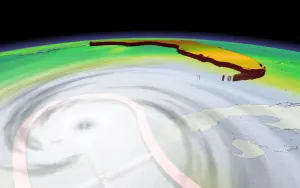
Fiona creates more habitat for piping plover but no big boost expected
There is good news for fans of piping plovers worried about damage from post-tropical storm Fiona.
Wildlife experts said the storm actually created more of the cobble beach that plovers prefer, with sand, gravel, small shells and limited vegetation.
However, they said that will not necessarily give the endangered species a boost this summer, even with the additional habitat.
"Hurricanes and large storm events often have the result of creating new and improved habitat for piping plover," said Shannon Mader, species at risk manager with Island Nature Trust.

Mader said large storm events often have the result of creating new and improved habitat for piping plover. (Shane Hennessey/CBC)
"We know we have more habitat, in areas where we haven't had it for years," Mader said.
"But really, we're just in the early stages of surveying all of our beaches across the Island. So it will be ongoing for the next couple of years."
Mader said that last year, there were 35 breeding pairs of piping plover on the Island, with the long-term goal being 60 pairs for Prince Edward Island.
The piping plover has been listed as endangered by the Committee on the Status of Wildlife in Canada since 1985.
ALSO READ: A massive, rare sea turtle washed up on P.E.I.
Similar storms
Mader said there have been similar storms to Fiona in the past, transforming beaches where the endangered bird nests.
"They did a lot of research in the U.S. after Hurricane Sandy in 2012," Mader said.
"They did see a significant increase in habitat, and after a couple of years, an increase in the number of birds as well."

Piping plover prefer to nest in beaches and tidal flats above the high-water mark, with sand, gravel or cobble and little vegetation. (Parks Canada)
However, Mader does not anticipate a similar impact on Prince Edward Island.
"Our population here is so small now that we can't necessarily extrapolate, and expect the same thing here," Mader said.
"We don't really believe that a shortage of habitat is the main threat for piping plover on P.E.I. Human disturbance is really the largest threat here, and predation to a certain extent."

Mader said the piping plover monitors will have a better sense of how many birds there are by the middle of June. (Submitted by Janette Gallant/Parks Canada)
Mader said the piping plover also face potential storm damage in their winter homes in the south.
"Both their breeding grounds and their wintering grounds are in hurricane paths," Mader said.
"We have had instances in the past — Hurricane Matthew, for example, hit their wintering grounds pretty hard."
'Hit or miss'
Parks Canada staff are also monitoring changes at Island beaches, including at Tracadie Beach, which has had nesting pairs of piping plovers over the last two years.
"We're starting to see localized habitat change post-Fiona," said Lindsey Burke, resource management officer with Prince Edward Island National Park.
"In some areas, we're seeing some of the cobble being buried over by sand, so less preferable for plover."

Lindsey Burke is a resource management officer with Prince Edward Island National Park. (Aaron Adetuyi/CBC)
"Other beaches, we're seeing an accumulation of cobble, shells, woody debris that might be more favoured by nesting plover," Burke said.
"So it's kind of hit or miss how it's changed, beach by beach."
Burke said that, as of June 6, eight pairs of piping plovers, 20 birds in total, have been detected on P.E.I. National Park beaches, and the resource conservation team is monitoring four nests.
She said it will still take time to determine what the final numbers for this year will be, and the full impact of Fiona.
"It's hard to say right now," Burke said.
"I think we want to get this season under our belts and see what's changed with the nesting behaviour."
Burke said the resource management team also monitors bank swallow and bat populations in the national park, and their habitat has also been altered by Fiona.
DON'T MISS: We finally found the famous Canadian singing sands, listen here
Thumbnail image courtesy of Parks Canada via CBC News.
This article, written by Nancy Russell, was originally published for CBC News.









